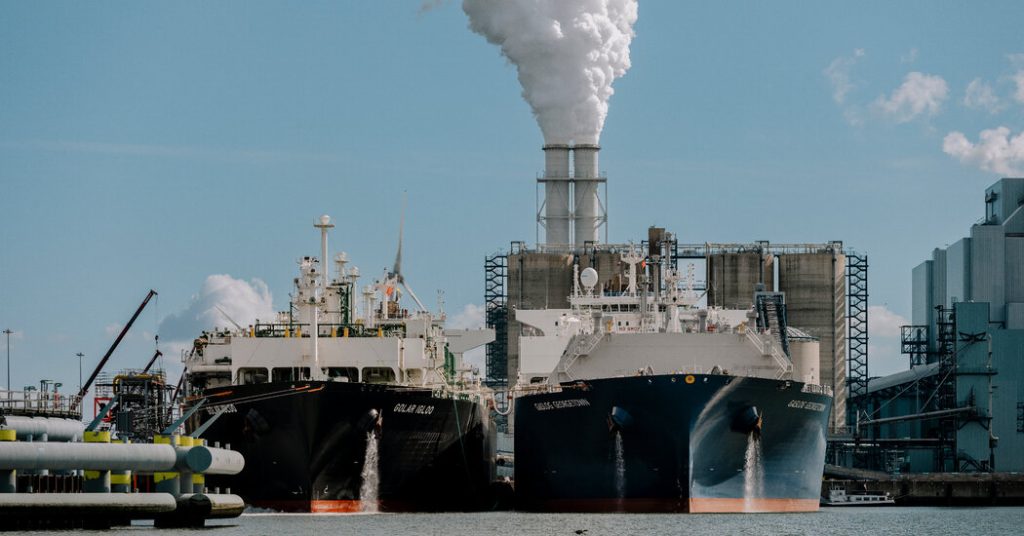At a newly built dock along Germany’s Elbe River, tankers from the United States unload liquefied natural gas to fuel factories and homes. In central Spain, a forest of wind turbines planted atop mountains helps power the energy grid. In French government buildings, thermostats have been lowered in winter to save electricity.
In the three years since Russia’s invasion of Ukraine ignited an energy crisis across Europe, the continent has transformed how it generates and stores power. Russian natural gas, long Europe’s energy lifeline, has been replaced with other sources, notably liquefied natural gas from the United States. Wind and solar power generation has leaped around 50 percent since 2021. New nuclear power plants are being planned across the continent.
But Europe’s energy security remains fragile. The region produces far less natural gas than it consumes and is still largely dependent on other countries, especially the United States, to help keep the lights on. Natural gas, which drives the price of electricity, is roughly four times as expensive as in the United States. High energy costs have strained households and forced factories to close, weakening Europe’s economy.
A dependence on Russia
The 2022 invasion of Ukraine revealed Europe’s dependence on energy from Russia, especially natural gas, which accounts for around 20 percent of Europe’s energy consumption.
“The energy appeared cheap, but it exposed us to blackmail,” Ursula von der Leyen, president of the European Commission, the European Union’s executive arm, told the World Economic Forum last month.
Prices soared in 2022 on worries that Russia would completely cut off gas flows into Europe as well as other factors. Countries banded together to share fuel and other energy sources, and build or modify infrastructure to transport it. These efforts are forecast to have reduced Europe’s reliance on Russian gas to 8 percent of supplies in 2025, from 35 percent in 2021, according to Anna Galtsova, an analyst at S&P Global Commodity Insights, a research firm.
Norway is now the largest supplier of gas, mainly through a web of pipelines. But Russia has become a large supplier of liquefied natural gas, second only to the United States in 2024.
And Europe has become better at directing the energy to where it is needed, creating “a tremendous amount of flexibility that Europe didn’t have on the eve of the war,” said Anatol Feygin, chief commercial officer at Cheniere Energy, a large American L.N.G. exporter.
Helping that pivot were programs that encouraged households and government buildings to lower thermostats to 19 degrees Celsius (66 degrees Fahrenheit). Factories across Europe also curbed production to avoid blistering energy bills. Other initiatives, like having stores shut off lights early in the evening, have been rolled out.
Renewable energy solutions
Europe built more renewable energy projects to help bridge the gap. Before Russia’s invasion, around a third of Europe’s power generation came from renewable energy, propelled by a buildup of wind and solar power. In 2024, wind and solar farms generated more electrical power than fossil fuels for the first time, according to S&P Global Commodity Insights.
“That is a big change, and that speaks to the additional policy push to get alternative sources of energy into the system,” said Tim Gould, chief energy economist at the International Energy Agency in Paris.
But shifting to renewable energy is costly. Although overall energy prices have declined from their 2022 peaks, both gas and electricity tariffs remain elevated. Renewable sources like wind and solar have made great progress, but much investment is still needed to fill in the gaps in periods of low wind and sun.
Large polluters like steel makers have said Europe is not doing enough to foster a shift to greener operations. “European policy, energy and market environments have not moved in a favorable direction,” ArcelorMittal, Europe’s largest steel company, said in November.
Global competition for gas
The largest alternative to gas piped in from Russia by far has been liquefied natural gas, but it is a relatively expensive option. With gas vital for industry, heating and power generation, the shift away from Russian supplies has been difficult.
Europe is at the mercy of global markets, bidding against the likes of China and South Korea for liquefied natural gas. Prices have recently soared to the highest level in a year, hurting businesses and adding to a cost-of-living crisis in Europe.
The largest source of liquefied natural gas has been the United States, mostly terminals from the Gulf Coast, which provide nearly half of Europe’s supply. Europe has seen a boom in setting up terminals to receive L.N.G., especially in Germany, which had none before the energy crisis.
During a cold snap in January, several American tankers carrying liquefied natural gas to Asia changed course for Europe, where they could make a bigger profit, said Natasha Fielding, head of European gas pricing at Argus Media, a London research firm.
“Europe has made really remarkable strides,” said David L. Goldwyn, who was a State Department energy envoy during the Clinton and Obama administrations. “But when the weather turns cold and competition from Asia for L.N.G. increases, the situation looks more challenging.”
Gas prices remain high
Natural gas prices in Europe have fallen from the punishing highs of 2022, but in 2024, they were still double their five-year average before the war, according to the International Energy Agency.
Although imports of Russian gas through Europe’s pipelines have plummeted, Europe has expanded its purchases of liquefied natural gas from Russia, which arrives via port. There has not been enough time to develop new resources like L.N.G. to compensate for the loss of Russian gas.
The ebbs and flows of L.N.G. are largely determined by market forces. President Trump has pushed Europe to import more fuel from the United States, and Ms. von der Leyen has suggested that L.N.G. from the United States could replace Russian fuel.
Some level of additional gas exports to Europe from Russia could be included as a sweetener for President Vladimir V. Putin of Russia to agree to a settlement in Ukraine, analysts say. “That would be a serious negative for U.S. energy exporters,” Mr. Goldwyn said.
The cost of the energy crisis
Exorbitant gas costs contributed to soaring inflation and led factories that employed thousands in Europe to close or relocate to countries with cheaper energy.
Some of the biggest European names are trimming their operations. The German chemical giant BASF said it would close some production at its site in Ludwigshafen near the border with France, while making the largest foreign investment in its history in China, where energy is up to two-thirds cheaper than in Europe.
High natural gas prices have translated into higher costs for making ammonia, a crucial component in fertilizers. Yara International, a fertilizer giant based in Norway, is stopping ammonia production at its plant in Tertre, Belgium, potentially leading to more than 100 job losses. “High energy prices are a huge challenge for European competitiveness,” a spokeswoman said.
The energy crisis has also led to a painful cost-of-living crisis for families across Europe. Energy poverty has jumped in Europe, with nearly 10 percent of the population reporting that it is unable to keep its homes warm, and larger numbers of households falling behind on paying their energy bills.
“We’ve created a state of energy precariousness,” said Niki Vouzas, spokeswoman for the National Federation of Rural Families in France. “People are heating their house less, and filling up the gas tank less.”
An uphill battle
Recent months have brought renewed signs of market unease. The colder weather has caused Europe to draw down the levels of storage it builds up for the winter at a faster rate than the previous year, leading to worries that rebuilding these stocks over the summer may be expensive.
“The challenge will be this summer to replenish the reserves ahead of the following winter,” Ms. Fielding of Argus said.
Despite the premium prices of recent years, Europe’s overall gas production has declined. Higher taxes have deterred investment in the British North Sea while the Netherlands is shutting the once prolific Groningen field after production triggered earthquakes. Domestic output in the European Union and Britain amounted to less than 20 percent of consumption in 2024, S&P Global Commodity Insights estimates.
Austria’s OMV is one of the rare companies aiming to increase gas production in Europe. The only way to make Europe’s energy costs competitive with other regions like the United States “is to increase supplies of gas” said Alfred Stern, OMV’s chief executive.
“We are past peak crisis,” said Michael Stoppard, global gas strategy lead at S&P Global Commodity Insights. “But we are not out of the woods.”








